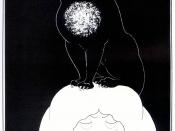The Labovian theory of a developed narrative contains six mandatory components. These components help the reader, or listener to a broader understanding of the thoughts and motivation of the internal narrator and the external storyteller. The abstract gives a representation about the story. The orientation draws a picture to familiarize the reader/listener of the necessary w's; who, what, when, where. The complicating action is the turn of events on which the story hinges. The resolution determines the outcome and usually leaves the reader/listener aware of a feeling of closure. The evaluation is the most essential component of the Labovian theory. It permeates throughout the narrative in hopeful attempts to keep the interest of the reader/listener peaked. The coda compliments the evaluation and brings the narrator and the reader/listener back together on common ground in order to bring the story to a close. Edgar Allan Poe's short story of a passionless crime undone by the heart incorporates the Labovian components.
'The Tell-Tale Heart' is a masterly written narrative, full of subtle nuances quick to deceive the senses. Poe sends the reader spinning into a world of symbolism, questioning the art of madness, and fearing the depravity of reason.
The 'The Tell-Tale Heart' is, at a glance, seemingly about a man plotting to kill another man in cold blood. Looking further into the words, the reader can find a story of a man obsessed with senses and the ability to have complete control over them. The narrator uses reason to overwhelm the morality of his actions. His obsession takes over his whole being, thus bringing on the madness which over powers his world. The focus of the abstract is first seen as the narrator describes his idea as, 'haunting him day and night'(226). Only an obsessed person could...


